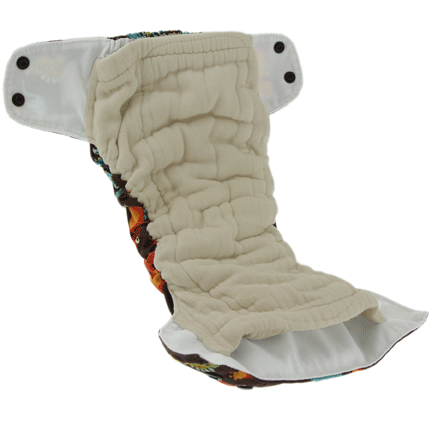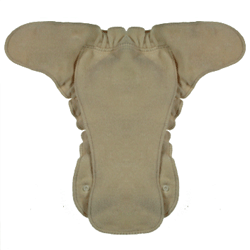

Types of Cloth Nappies
There are different types of cloth nappies. On this page you can learn all about each type, the benefits and challenges of each. It might seem overwhelming in the start but know it is well worth using cloth nappies.
Enjoy and remember to ask on our Facebook group if you need help

Pockets
A pocket nappy consists of a waterproof cover with a pocket lining sewn in with either one or two openings in the lining. The pocket lining can either be made from synthetic fabric (stay-dry) or natural fibres. Inserts are stuffed into the pocket lining. Inserts absorb the urine. Inserts can be made of a variety of fabrics, the most popular being microfibre, bamboo and hemp.
How many do I need for full time use?
You will need about 24 pockets to wash every second day*
Strengths
-
Widely available
-
Affordable
-
Quick drying
-
Customisable absorbency (you can use 1, 2 or 3 inserts)
Weaknesses
- It can get tedious to stuff pockets
- You need to remove soiled inserts before washing
- Not the best option for heavy wetters due to limit in how many inserts you can add
- Not an ideal option for night time cloth unless you have an extremely light wetter
- The entire nappy (Inserts and cover) needs to be washed after
* NOTE: OSFM will only start fitting when baby is 5+kg (brand dependent, some will only fit 7+kg). For newborn phase you will need 32 nb pockets to wash every second day. Just note that newborn pockets have a very small insert and ,therefore, nappies that can absorb fully (eg fitteds, prefolds and flats) are recommended for newborn stage since it can cope better with the output.

All-in-one (AIO)
An AIO is the closest to a disposable nappy in terms of putting it on your baby as it can be used just as-is. AIO has a waterproof outer layer and sewn in absorbent fabric.
How many do I need for full time use?
You need about 24 AIO's to wash every second day. *
Strengths
-
Easy to use as it is a one-step proccess
-
Most like a disposable
-
Trim fit
-
Requires no or minimal assembly
Weaknesses
-
Most expensive type of cloth nappy
-
Need to wash the whole nappy after each use
-
Can take a long time to dry (Depending on how the layers are sewn-in)
* NOTE: OSFM will only start fitting when baby is 5+kg (brand dependent, so will only fit 7+kg). For newborn phase you will need 32 nb AIO's to wash every second day. Just note that newborns pee a lot for the size of the nappy ,therefore, nappies that can absorb fully (eg fitteds, prefolds and flats) are recommended for newborn stage since it can cope better with the output.

Snap-in-one (SIO)
A SIO is an AIO with snap in inserts. It should not be confused with an AI2 since it can only be used once before needing to be washed (Since the cover is not reusable between washes as it will absorb some urine). This type of AIO is beneficial as it will dry quicker, but requires a little more effort (sorting and attaching inserts before using).
How many do I need for full time use?
You will need about 24 SIO's to wash every second day*
Strengths
-
Easy to use as it is a one step system
-
Trim fit
-
Requires minimal assembly
-
Faster drying than an AIO
Weaknesses
- Expensive
- Need to wash the whole nappy after each use
- Takes a bit more time to match inserts with covers (compared to an AIO)
* NOTE: OSFM will only start fitting when baby is 5+kg (brand dependent, some will only fit 7+kg). For newborn phase you will need 32 nb SIO's to wash every second day.

All-in-two (AI2)
AI2 is a two step system. You have a cover that is waterproof (usually PUL or TPU) and inserts. Inserts are the absorbent part of the cloth nappy. Inserts typically snap into the cover, but can also just be laid on top of the cover.
How many do I need for full time use?
You will need about 6 - 8 covers and 24 inserts to wash every second day. *
Strengths
-
Can reuse the cover in between washes and simply replace the insert with a clean, dry one
-
Very economical for high quality as you need fewer covers (the expensive fabric part of a cloth nappy)
-
Easy to use, just snap in the inserts and it's ready to put on baby
-
Trim fit
-
Dries relatively quickly (dependent on insert fabric)
-
Great for out & about or travelling as it takes up less space than pockets or AIO/SIOs
Weaknesses
-
With some covers you will have PUL touching baby's skin (on the hips). This is personal preference, some babies my have a sensitivity with PUL directly on the skin
-
Not ideal for ebf poop as the insert might not catch everything, so you might not be able to reuse the cover before washing in this case
-
Requires some assembly
* NOTE: OSFM will only start fitting when baby is 5+kg (dependent on brand, some might only be at 7+kg). For newborn phase you will need 32 nb inserts and about 8-10 nb covers to wash every second day.

Hybrid Fitted
Hybrid fitteds are usually made by WAHM's, they have a water-resistant layer (usually fleece) sewn in, but will need a cover to be fully waterproof
How many do I need for full time use?
Hybrid fitteds should be part of a variety stash, you can get 3-4 for night time use and add a few for day time use according to personal preference
Strengths
-
Entire nappy is absorbent
-
Most breathable type
- Beautiful and unique prints
Weaknesses
-
Bulky
- Takes long to dry
- Needs a cover for night use for heavy wetters (can last about +- 2 hours coverless depending on fabrics used and type of wetter)
- Expensive
- Wide variety of quality, do your research and make sure you get a reputable brand to avoid unnecessary leaks or fit issues
NOTE: In the US AI2's are also referred to as hybrids as some brands have a choice of cloth or disposable inserts with the reusable cover. This is not the same as hybrid fitteds.

Fitted
A fitted is a fully absorbent tailored fitted nappy that needs to be used with a cover. It comes with snaps or velcro. Snapless fitteds (elasticated contours) are fastened with snappi's or nappy pins.
How many nappies do I need?
You need about 3-4 to wash every second day if you are using them as night nappies. Fitteds can also be used as daytime nappies and are a great option for newborns and heavy wetters. In this case you will need 36 for newborn or 24 for older babies to wash every second day.
Strengths
-
No folding required
-
Very absorbent
-
Relatively easy to use
Weaknesses
- Needs a cover
- Can take longer to dry
- Tends to be bulky

Prefold
Prefolds are old style cloth, one step up from flats (see below). It's an absorbent inner layer that can be used with any cover. It comes in a rectangular shape with extra absorbent layers sewn in the middle. Many of the locally available prefolds have wings to wrap around baby's waist. You can either padfold it and lay in cover, stuff in a pocket cover, or snappi onto baby. Prefolds come in different sizes. You can find different prefold folds here (applicable to rectangular prefolds).
How many do I need for full time use?
For newborn phase you will need 36 prefolds and 8-10 covers to wash every second day. The newborn prefolds also work great as boosters for older baby or toddler. For toddler stage you will need about 24 prefolds and 6-8 covers to wash every second day
Strengths
-
Very absorbent
-
Easier to use compared to a flat (less folding)
- Versatile: can be used as a booster or inserts as well
- Usually made from natural fibres
Weaknesses
-
Needs a cover
- Can take a little bit of practice if using a snappi
- Need different sizes for different ages

Flat
Flats are old style cloth - think terry squares ("Spoegdoeke"). The fabrics that are popular today are just trimmer than the old terry toweling nappies. It's a single layer of absorbent fabric cut in a large square. There are many ways of folding a flat to use as a nappy. Most folds need to be secured with a snappi or pins. They are available in a few sizes: Newborn (50 x 50 cm), Small/Medium (60 x 60 cm) and OSFM (70 x 70 cm). You can find flat fold tutorials here.
How many do I need for full time use?
For newborn phase you will need 36 flats and 8-10 covers to wash every second day. The newborn flats also work great as boosters for older baby or toddler. For toddler stage you will need about 24 flats and 6-8 covers to wash every second day
Strengths
-
Very trim option if you use flannel, skinny/unbrushed cotton fleece or hemp
-
Very absorbent
-
Fastest drying cloth nappy
-
Cheapest option
-
Easy to hand wash
-
Great for holiday cloth since it doesn't take a lot of space in a suitcase and dries quickly in case of needing to hand wash
-
Customisable fit (different types of folds)
Weaknesses
-
Needs a cover
-
Has a learning curve to fold flat and snappi/pin on baby
-
A bit more effort to get on baby than other modern nappy types if baby/toddler is squirmy or moves a lot (unless well practiced at it)

Trainer
Trainers are pull-up type cloth nappies that can be used for potty learning. It doesn't have the same absorbent capabilities as other types of cloth nappies, so it works more effectively as a backup option to catch small accidents rather than a full cloth nappy option. Trainers are not necessary in every cloth nappy journey and can be used depending on personal preference.
Strengths
-
Depending on needs can be helpful in potty learning
- Can pull up and down like underwear
Weaknesses
- Prone to leaks as it isn't capable of holding a full toddler pee

Other
Booster - An extra insert to boost any type of nappy's absorbency, usually smaller than a pocket or AI2 insert. PRO TIP: Use your newborn prefolds or newborn flats as boosters in older baby's or toddler's nappies
Liner - Disposable or reusable liner to catch toddler poop (very thin and goes on top of nappy). Please note most disposable liners eventhough they say they are flushable can block your drains. Reusable liners are usually made of fleece as poop rinses off it easier and it prevents stains on your cloth nappy
Soaker - Wool or fleece soaker functions the same as a PUL cover but it is more breathable. Sometimes boosters/inserts are also referred to as soakers (this is more common in the US)

Variety stash recommendation
Please note the "how many you need" question is just a guideline for each cloth type and how it works in terms of number of uses. It's highly recommended to have a variety stash (In brands and types). Different types and brands will work better in different situations and stages of your baby's growth.
If you are unsure of how to build a variety stash, we have some great suggestions for a variety stash to suit your particular needs.





Night time cloth can seem daunting at first, but once you have the right solution it works just as well as day time cloth.







